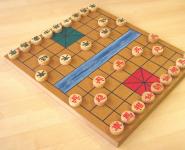goat domino rules
Preparing for the game
The game set includes 28 unique bones:
0-0, 0-1, 0-2, 0-3, 0-4, 0-5, 0-6
1-1, 1-2, 1-3, 1-4, 1-5, 1-6
2-2, 2-3, 2-4, 2-5, 2-6
3-3, 3-4, 3-5, 3-6
4-4, 4-5, 4-6
5-5, 5-6
6-6
Tiles with the same value on both halves (0-0, 1-1, 2-2, 3-3, 4-4, 5-5 and 6-6) are called doubles.
The game is played by two to four people.
The game of "Goat" is divided into rounds.
At the start of each round, players randomly pick up seven dice.
If a player has five or more doubles or six or more dice with a repeated value in his hand, the dice are re-dealt.
If less than four people take part in the game, then the extra dice remaining after the surrender are closed are moved to the edge of the table. These bones are called "bazaar".
The first move in the first round belongs to the player who has a 1-1 double in his hand. It is from this double that the participant must enter. If no one has such a double in their hands, then one of the participants who has a double 2-2 in his hands goes. And so on until bone 6-6. If none of the participants has a dice 6-6, then the first move from a double is 0-0. If there are no duplicates at all, then the move from the bone is 5-6, and so on in descending order of the values of the bones.
The turn is passed clockwise. Each next player must place a dice, the value of which is equal to the value of the dice already placed on the table on the side of contact.
If the player does not have suitable dice, then he “goes to the market”, that is, he blindly draws one of the extra dice deposited on the edge of the table. This continues until the player finds a bone with the required value. If there is no "bazaar" or it has ended, and not a single bone has come up, the player "knocks", that is, he skips the move. All the bones taken at the “bazaar” remain in his hands.
A player does not have the right to skip a move if he has a bone in his hand that can be played.
A player can only place one bone per move.
The round ends when one of the players has no bones left in their hands, that is, the player “left”, or when the player bets “fish”. The first move in the next round is made by the "left" player, or "fisherman", that is, the one who put the "fish". He can walk from any bone.
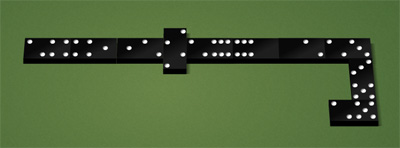
"Fish" refers to a situation in which all players have bones in their hands, but are unable to walk. A similar situation is possible when all six (not counting the double) bones with the same value are laid out on the table and both ends of the chain close the bones with the same value.
For example, dice 1-2, 2-6, 0-2, 2-3 are already laid out on the table. The chain ends with a 2-4 bone on one side and a 5-2 bone on the other. This is a fish".
If the 2-2 double was not played as shown in the picture, but was in the “bazaar” or in the hands of one of the players, it would still be a “fish”.
If the round ends not with a fish, but simply with the “exit” of one of the participants who got rid of all his bones, then the remaining players open their bones and count the sum of the points of these bones.
Scoring
If at the end of the round the player has one single 0-0 bone left in his hands, then it is considered as 10 points. All other dice are considered at face value.
If the sum of the player's bones does not exceed 12 points, then this number is "remembered" for the next round after the player. If in the next round the player again scores an amount of 12 or less points, then the new amount is added to the old "memorized" amount and goes into the "remembered" amount for the next round. If the player "left", then all his "remembered" points are reset.
If a player scored more than 12 points in a round, then he opened his account in the game. If the player had "remembered" points at the time of opening the account, then they are added to the accumulated amount. From the moment the account is opened, the points are not "remembered" and any, even the smallest, number of points scored in the round will immediately be added to the player's account.
All points scored or "remembered" by players are displayed on the screen next to the login. "Memorized" points are displayed in yellow. Before the sum of points there is a "+" sign
An open account is displayed in red, without the "+" sign
Consider the scoring system using the example when one of the players " came out»
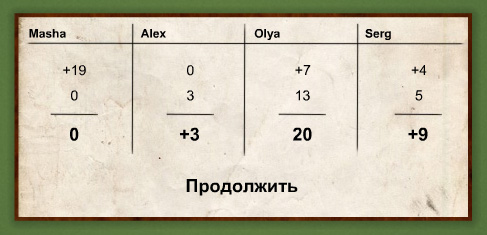
The top number in the table is the points scored in the previous rounds.
The number in the middle (above the line) is the amount scored in the current round.
The number below the line is the total score.
In the example we are considering, the player Masha "left" because she scored 0 points. Prior to this round, she had 19 "memorized" points. Since the player is “out”, his memorized points are reset to zero and the total amount is zero.
Player Alex did not have any points at the beginning of the round, but in the current round he scored 3 points. Since 3 points is less than 12 and the player did not open an account, he received +3 “remembered” points as a result.
Player Olya at the beginning of the round had +7 "remembered" points. In the current round, she scored 13 points and thus opened the scoring. As a result, she received 13 + 7 = 20 points.
Player Serg had +4 "remembered" points at the beginning of the round. He scored 5 points in the round. Thus, he did not open an account, but the "remembered" points were summed up. He now has +9 "remembered" points.
If the round ends with a "fish", then there are several options for the rules by which the scoring is performed. When creating a request for a game, you can set one of these options by changing the corresponding parameter. Now let's look at each of them with an example.
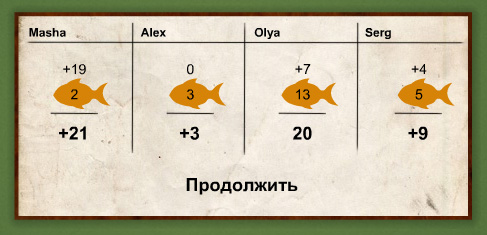
Let's call the first version of the rules " fish for everyone". In this variation, scoring is no different from the normal scoring mechanism. The only difference is that each player in this round has scored points, as there is no "out" player.
Let's take a look at the table. In the middle line of the table, the icons of "fish" are drawn. They tell us that the round ended with a fish.
Let's call the second option fish for one". In this variant, not only the points of each player are calculated, but also the sum of the points of all the bones remaining in the hands of the players. As a result of scoring, the player who scored the most points in this round is found. It is to him that the sum of the points of all the bones remaining in the hands of the players is added. Let's look at an example:

In this round, the player with the nickname Masha scored 2 points, Alex - 3 points, Olya - 13 points and Serg - 5 points. So the total points scored by the players is 23.
Olya scored the most points in the round, she has 13. So, it is she who receives the total amount of points scored by all players. This is 23 points. In addition, she had "remembered" 7 points, which are added to the amount when opening an account. As a result, Olya gets 30 points. Let's pay attention to the fact that the memorized points of other players have been reset.
Another situation is also possible, when several players score the same maximum number of points. For example:
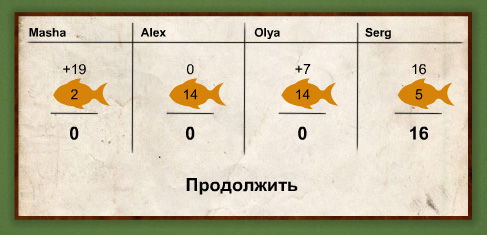
Players Alex and Olya scored the most points. Each of the bottom 14. In this case, the round is considered to be played "draw". The entire amount of fish (35 points) goes to the next round.

This situation is also displayed on the screen. In this case, a fish icon appears under the timer. It displays the number +35, that is, the amount that has passed over the fish from the last round.
In this case, in the next round, regardless of its outcome (whether it ends with a regular exit or a “fish”), the player who scored the maximum number of points will receive, in addition to his account, the entire amount transferred from the last round.
If the round again ends with a “fish” and the situation with the same maximum number of points repeats again, then the results of the new round will be added to the memorized amount and the total memorized amount for two rounds will go to the next one.
This will continue until there is one player who has scored the maximum number of points.
Game results
The game is considered over as soon as one of the players scores 101 or more points. A player who scores 101 or more points in total according to the results of the rounds is considered a loser, that is, he becomes a “goat”.
Calculation of the rating for the game "Goat"
(100 − [sum of player points]) / 10
For example:
Masha scored 25 points.
We substitute the value in the formula, we consider: (100 - 25) / 10 = 7.5.
Round up = 8.
Thus, according to the results of the game, Masha's rating will increase by 8 points.
If the game is interrupted by a timeout, then the player who left the game by timeout does not receive rating points.
All other players in this case receive points to the rating. The rating is calculated according to the following formula:
([points of the player who was eliminated by timeout] - [the sum of the points scored by the player]) / 10
with rounding according to the rules of mathematics, but with the condition that the result cannot be less than 1 point.
For example:
Alex scored 32 points and was eliminated by timeout. He does not receive rating points.
Masha scored 30 points, despite the fact that the game was interrupted due to a timeout, but not through her fault.
We substitute the value in the formula, we consider: (32 - 30) / 10 = 0.2
Round = 0.
But we remember that the result cannot be less than 1 point. Thus, the rating of the player Masha will increase by one.
Olya scored 13 points, despite the fact that the game was interrupted due to a timeout, but not through her fault.
We substitute the value in the formula, we consider: (32 - 13) / 10 = 1.9
Round up = 2 points.
Thus, according to the results of the game, Olya's rating will increase by 2 points.
Dominoes "Goat" online at LiveGames: description and rules
Domino Goat Rules
A standard set of dominoes consists of 28 tiles. The domino bone has the shape of a rectangular tile. The front side of the bone is divided by a line into two square parts. Each of the parts contains from zero to six points. The reverse side of the bone is usually flat.
Interface appearance:

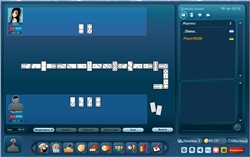
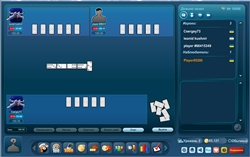
Our project presents a kind of domino game - "Goat".
The game is played by 2 to 4 players. Each player is dealt 7 tiles at the beginning.
The player with the smallest double goes first. The next draw is started by the player who won the previous game or called "fish".
The next player must place a tile with the same number on either side, and so on. The bones available for the move are highlighted. If the players have nothing to walk with, they go to the "bazaar" and pull out the bones, in our project the bones are issued automatically until the necessary one is found. The first player to lay out all their tiles wins.
The losers in each draw are credited with the number of points on their remaining tiles.
The situation in which no player can lay out the required bone is called "fish". In this case, the winner is the one who has the bones in his hands with the smallest total number of points.
The number of points can be viewed by clicking the Score button.
The player who first scores 101 points is declared the "goat" - the loser.
According to the results of the game, those players who scored 101 points or more are considered losers. The bank of the game is divided between the other players in inverse proportion to the points scored.
play.livegames.ru
Goat domino rules

How many dominoes to distribute per player?
Depends on how many people will play, a maximum of 4 players is possible.
- 2 players - take 7 dice each;
- 3–4 players - take 5 dice each;
- Empty or empty-empty (0–0) - count as 25 points;
- Bone 6–6 - count as 50 points;
- All other stones give how many points, how many points on them. For example, a dice 1-4 is 5 points, a dice 6-4 is 10 points, a dice 3-5 is 8 points, and so on.

5 End game
The game ends when one of the players runs out of dice or when a "Fish" is obtained. All other players with dice in their hands begin to count points.
Scoring
Before the start of the game, the players agree on how many points they will play dominoes, for example, 300 points. This means that the one who scores the first 300 points wins. After each game played, the winner gets points from the stones that were left in the hands of the losing players.
Which bone gives how many points?

The losers in each draw write down the amount of points on their remaining bones on their account. To start recording, you need to score more than 12 points.
In case of "fish" in case of an equal number of points left by the players, "eggs" are announced. Attributed to the loser in the next round or to the player who has more points left in the case of a "fish".
The game is played until one of the players gets 101 or more points. The first player to score more than 100 points is declared the loser.
Domino rules "Donkey"
The rules of the game are the same as in Goat dominoes, but they have several differences:
Scale and full screen mode- using the panel to the right of the "Settings" button, you can change the scale on the field and turn on / off the full screen mode.
Description- opens the description of the game.
Questions and feedback- opens the guest book, where you can leave a review or a wish for the game.
Story- the history of all your games with the date of the game, the opponent and his place in the ranking.
The games you won are marked in yellow, the games you lost are marked in red, and the games you ended in a draw are marked in blue.
An asterisk marks games that you have added to your favorites.


Points are awarded only for victories over opponents (no points are awarded for draws and victories over the computer).
Points are awarded according to the Elo system.
Elo rating system, Elo coefficient - a method of calculating the relative strength of players in games in which two players participate. This rating system was developed by Arpad Elo, an American physics professor of Hungarian origin.
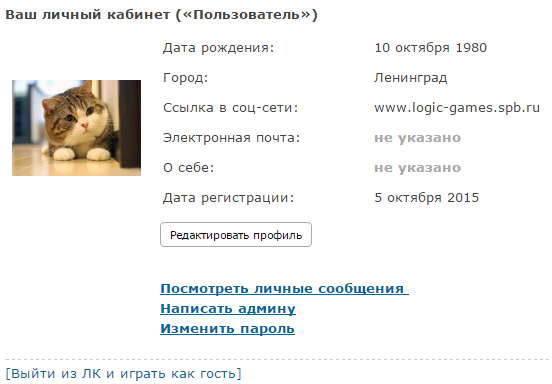
In your personal account, you can specify additional information about yourself, upload a photo, change your password, as well as store and carry out personal correspondence with other registered players.
You can play without registering as a guest. After registration and / or authorization, you will get access to your personal account and will be able to send private messages to other players.
To register, you just need to enter a name (at least 3 characters) and a password (at least 5 characters). If such a name is already registered in the game, you will have to choose a different one.
logic-games.spb.ru
Domino game rules
Dominoes is a game of 28 stones with points marked on them from zero to six.
Game of Chinese origin. It was brought to Europe by the Italian traveler Marco Polo (1254-1324). The modern name and goes back to it. domino - lord, master. At first, in Italy, the game spread in Catholic monasteries and religious communities.
When the player laid out the first bone, he said: "benedicamus Domino" (benedicamus Domino) - "praise the Lord." Or pronounced "Domino gratias" (Domino gratias) - "thanks to the Lord." According to one version, this is how it turned out in the abbreviation just the word "domino".
TRADITIONAL RUSSIAN DOMINO GAME - "GOAT"
Domino rules are easy and accessible even to preschool children. The game "Goat" is played by four players: two players against two others.
All 28 stones, facing down, are mixed on the table. Then the players pull seven stones, of course, without showing them to each other.
They come in with a double 1-1. The owner of this double puts it on the table in the open. The game continues, as a rule, clockwise. The next player puts a suitable stone (for example, 1-5) on one of the long sides of the existing double with its short side. Then the players continue to build a chain of stones, putting one of their stones with the corresponding number of points (on the half) to the end of the layout-path, and the doubles are always placed across. If necessary, the display can be rotated by an angle (by 90°). If the player does not have the required stone, then according to the rules of the game, he skips the move.
The rules of the game of dominoes say that the round of the game ends when one of the players places his last stone or when no one can make a move, i.e. if the game is blocked ("roof").
When either side wins, the sum of the opponents' points is credited to its account. The game of dominoes Kozel admits that if the sum is less than 13 (only for the side that has not yet recorded a single point for itself), it is not recorded at all, the owner of the 1-1 double starts the next round again, and the unrecorded sum in case of a second win (more than 13 points ) is added to the points won.
In the case of the “roof”, opponents compare their points. Whoever has the least amount wins. They record the sum of the points of the opposite side. In case of equality of points (“fish”), the sum of points of all four participants goes to the side that wins the next round.
The next round is opened by the player who completed the previous one (or made the "roof") by entering from any stone.
The goat domino game continues until either side scores a total of 101 points or more (they remain goats).
sea goat
The rules of the domino game for the Sea Goat game indicate that two against two are played up to 202 points.
Partners win only if their opponents do not score any points. If one of the parties wins the round, but the other still does not lose "dry", then all points are deducted.
In one move, a player can place two doubles at once on both ends of the calculation.
Other Domino Rules "Sea goat" remain unchanged.
